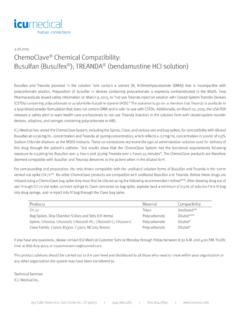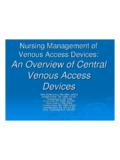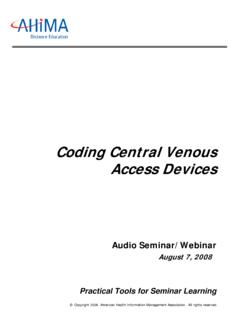Transcription of The Hemodynamic and Physiological Relevance of …
1 SvO2/ScvO2 (mixed or central venous oxygen saturation) is an important yet frequently misunderstood Hemodynamic Hemodynamic and Physiological Relevance of Continuous central venous Oxygenation Monitoring: It s Not Just for SepsisEric Reyer, DNP, ACNP, CCNS, 2013 OVERVIEWSvO2/ScvO2 (mixed or central venous oxygen saturation) is an important yet frequently misunderstood Hemodynamic parameter. Specifically, its use in patients other than those in cardiac surgery and with sepsis has not been widely understood as a useful tool in decision-making with critically ill patients. This paper covers tissue oxygenation and the role of continuous central venous oxygenation monitoring in the assessment of both potential oxygen delivery and consumption in the typical critical care POTENTIAL OXYGEN DELIVERYThe normal oxygenation cycle begins with deoxygenated blood entering the right side of the heart. As hemoglobin molecules pass out of the right side of the heart and through the lungs/alveoli, four molecules of oxygen become attached to each individual hemoglobin molecule.
2 This oxygenated blood then passes through the left side of the heart and out to the tissue. Upon reaching the capillary beds, an average patient extracts one molecule of oxygen from each hemoglobin molecule, leaving the red blood cells 75% saturated with oxygen as they return back to the right side of the amount of oxygen saturation in the arterial system as it passes into the capillary bed is referred to as potential oxygen delivery (DO2), as extraction has not yet occurred. In the early days of measuring DO2, blood had to be sampled directly from an artery and the amount of oxygen/saturation was measured through instrumentation outside the Continuous pulse oximetry, or SpO2, was widely used in the operating room beginning in the 1980s. As the technology was simplified, its use in critical care areas emerged in the early to mid-1990s. Because of the cost of this technology, most hospitals only acquired a handful of these monitors in their ICUs and emergency departments.
3 Medical staff would use the same monitor and go bed to bed at specified times, obtaining a reading of each patient s arterial oxygen saturation. This snapshot in time was quickly recognized to be unacceptable because a patient s physiology is constantly changing, sometimes rapidly. Continuous SpO2 monitoring was adopted as a standard in all ICU patients in the mid to late 1990s as clinicians learned that one value obtained at regular intervals was not sufficient to treat serious and critically ill PAPERThe intermittent measurement of a patient s central venous oxygen saturation does not give a clinician enough information to make good decisions because the saturation levels may vary from minute to , 7 INCREASING POTENTIAL OXYGEN DELIVERY: FOUR METHODSM easuring DO2 is dependent upon hemoglobin/hematocrit, cardiac output, and saturation of the individual hemoglobin molecules. Increasing potential oxygen delivery can be achieved in four ways:1.
4 The first, and simplest, form is to increase inspired oxygen or FiO2. Assuming that a disease process is not inhibiting the transfer of oxygen in the alveolar beds, there should be a rise in partial pressure of oxygen and subsequent saturation of hemoglobin , 2, 4, 52. Mechanical ventilation can be used for patients who require assistance in either the movement of oxygen into the lungs or who require more pressure for oxygen to transfer across the alveolar membranes. BiPAP, endotracheal intubation, and advance ventilator modes such as Airway Pressure Release Ventilation (APRV) and oscillation increase the movement of O2, including controlling pressure both during inspiration and at end expiration. Using mechanical ventilation, Positive End Expiratory Pressure (PEEP) can be increased, stretching alveoli to maximize their surface area and resulting in increased oxygen transference into the , 53. Though recent research has shown that blood transfusions may increase mortality in many patient populations, increasing hemoglobin levels through transfusion of packed red blood cells may result in extra oxygen-carrying capacity.
5 In simple terms, if you increase the amount of hemoglobin molecules crossing the capillary beds, there is more potential for oxygen to be extracted because more oxygen molecules are present. This treatment should be reserved for disease processes shown to require transfusion rather than being based on lab values alone, as blood is a liquid transplant and has many adverse , 64. The final way to increase potential oxygen delivery is to deliver more blood volume directly to the tissues. Increasing cardiac output (CO) does this by maximizing the amount of blood exiting the left side of the heart that is directly pumped to the capillary beds. CO is composed of stroke volume (the amount of blood pumped from the left ventricle during each cardiac cycle) times heart rate: CO = SV x methods exist to increase CO depending upon the patient s Hemodynamic status, overall condition, and disease process. The appropriate method/intervention should be chosen based on current Physiological , 7 MEASURING venous OXYGENATIONAs blood returns to the right side of the heart, venous oxygenation can be measured through saturation of the hemoglobin molecules.
6 This was first done, just as with arterial oxygenation, by obtaining a blood sample from the central circulation and measuring the oxygen level, the partial pressure, and/or hemoglobin clinicians still use this outdated practice of measuring central venous oxygen saturation, giving them only a snapshot in time. As we learned with arterial saturation (SpO2), this method of monitoring does not give a clinician enough information to make good decisions because a patient s condition may vary from minute to , 71009080706050400 10 20 30 40 50 60 venous Saturation (%)t (min)ScvO2 SvO2 Continuous ScvO2 monitoring can be easily achieved through the use of the same triple-lumen central venous catheter currently accepted as the standard of care in critically ill SvO2/ScvO2 is measured through technology similar to SpO2. Various wavelengths of light are emitted from the tip of a catheter that is located in the pulmonary artery using a PA catheter (SvO2), or the superior vena cava using a central line (ScvO2).
7 As these wavelengths of light are reflected back to the receiver on the tip of the catheter, venous oxygen saturation is measured and displayed continuously in real the normal oxygen cycle delivers one molecule of oxygen in the capillary bed, the average healthy person should have a venous oxygenation saturation of around 70 to 80%. ScvO2 measures oxygen saturation returning from the upper , 3, 7 The value runs approximately 5 to 10% higher than SvO2. SvO2 measures saturation of blood returning from both the lower and upper body mixed with coronary return. Research has proven that these values correlate exactly, thus allowing ScvO2 to be utilized in a less invasive manner as a replacement, or surrogate, for the more invasive SvO2. Most critically ill patients require the use of a central venous catheter. Continuous ScvO2 monitoring can be easily achieved through the use of the same invasive practice (triple-lumen central venous catheter) currently accepted as the standard of care in critically ill This means that no other devices need to be , 9 The following graphic shows venous saturation by minutes for ScvO2 and SvO2.
8 venous Saturation Although ScvO2 values run approximately 5 to 10% higher than SvO2, research has proven that these values correlate exactly, thus allowing ScvO2 to be utilized in a less invasive manner as a replacement, or surrogate, for the more invasive more accurate technology monitors central venous oxygenation independent of hemoglobin levels using three wavelengths of light instead of two, making calibration unnecessary except when first taking it out of the package. COMPARING FIBER OPTIC TECHNOLOGIES FOR GATHERING ScvO2 AND SvO2 DATAS everal fiber optic technologies are available in the medical industry to gather SvO2/ScvO2 data. The first uses only two wavelengths of light, resulting in limited capability because it requires the hemoglobin level to be constant. This forces the user to calibrate the catheter at least daily, including entering frequent hemoglobin values. The other limiting factor with this method is that the value measured can be inaccurate if there is a small change in hemoglobin, which is frequent in critical care more accurate technology monitors central venous oxygenation independent of hemoglobin levels using three wavelengths of light instead of two, making calibration unnecessary except when first taking it out of the package.
9 It is available as both an integrated model (built into a standard triple-lumen central venous catheter) or as a small probe that can be easily advanced down the distal lumen of a previously inserted dwelling central venous In addition, a new technology utilizing the same three-wavelength fiber optic bundle delivered less invasively through a peripherally inserted cardiac catheter (known as a PICC line) is pending FDA 510(k) clearance and may allow for more widespread adoption of ScvO2 monitoring outside the OR and ICU. ICU Medical s TriOx central venous oximetry catheter and probe are currently the only technologies providing three-wavelength oximetry for greater accuracy in assessing real-time tissue oxygenation DECISIONS IN TREATMENT AND PLAN OF CAREC ontinuous measurement of both ScvO2 and SpO2 allows us to calculate oxygen consumption by subtracting the two values. In a normal patient, there is 25% extraction of oxygen based on the normal values of each of these monitoring techniques.
10 Through interpretation of these values, ScvO2 can indicate a change in either oxygen delivery or consumption. As stated earlier, oxygen delivery is composed of CO, hemoglobin, and SpO2. Changes in oxygen consumption can be from metabolic rate, oxygen extraction rate, or many other physiologic processes that will be discussed , 7-9 As with all Hemodynamic monitoring, a value must be interpreted through analyzing all the parameters together, including the patient s condition, to make much earlier and better decisions in treatment and plan of oxygen demand increases in a healthy person, the body attempts to maximize delivery by increasing cardiac output and respiratory rate. ScvO2 values should remain in the normal range as the person compensates for this increased demand. If the body is unable to compensate because of disease processes or other physiologic problems, tissues extract more than one oxygen molecule, resulting in lower venous oxygenation saturation as evidenced by a decrease in , 4, 7, 13 Clinicians must keep in mind that patients compensate differently.

















